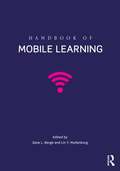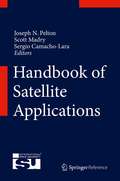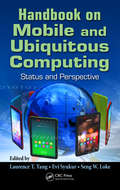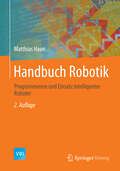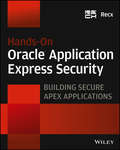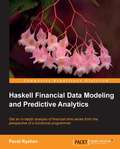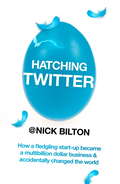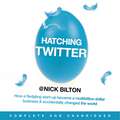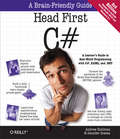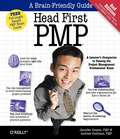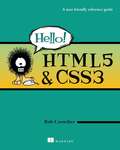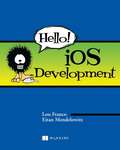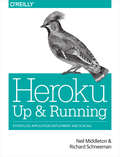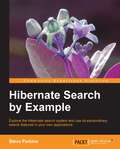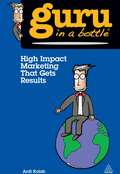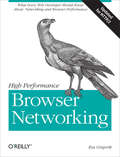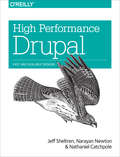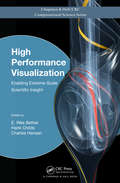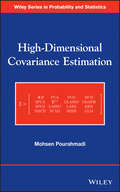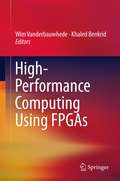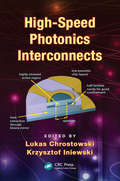- Table View
- List View
Handbook of Iris Recognition
by Mark J. Burge Kevin BowyerThis authoritative collection introduces the reader to the state of the art in iris recognition technology. Topics and features: with a Foreword by the "father of iris recognition," Professor John Daugman of Cambridge University; presents work from an international selection of preeminent researchers, reflecting the uses of iris recognition in many different social contexts; provides viewpoints from researchers in government, industry and academia, highlighting how iris recognition is both a thriving industry and an active research area; surveys previous developments in the field, and covers topics ranging from the low-level (e.g., physics of iris image acquisition) to the high level (e.g., alternative non-Daugman approaches to iris matching); introduces many active and open areas of research in iris recognition, including cross-wavelength matching and iris template aging. This book is an essential resource for anyone wishing to improve their understanding of iris recognition technology.
Handbook of Mobile Learning
by Zane L. Berge Lin Y. MuilenburgThis handbook provides a comprehensive compendium of research in all aspects of mobile learning, one of the most significant ongoing global developments in the entire field of education. Rather than focus on specific technologies, expert authors discuss how best to utilize technology in the service of improving teaching and learning.
Handbook of Neuroevolution Through Erlang
by Gene I. SherHandbook of Neuroevolution Through Erlang presents both the theory behind, and the methodology of, developing a neuroevolutionary-based computational intelligence system using Erlang. With a foreword written by Joe Armstrong, this handbook offers an extensive tutorial for creating a state of the art Topology and Weight Evolving Artificial Neural Network (TWEANN) platform. In a step-by-step format, the reader is guided from a single simulated neuron to a complete system. By following these steps, the reader will be able to use novel technology to build a TWEANN system, which can be applied to Artificial Life simulation, and Forex trading. Because of Erlang's architecture, it perfectly matches that of evolutionary and neurocomptational systems. As a programming language, it is a concurrent, message passing paradigm which allows the developers to make full use of the multi-core & multi-cpu systems. Handbook of Neuroevolution Through Erlang explains how to leverage Erlang's features in the field of machine learning, and the system's real world applications, ranging from algorithmic financial trading to artificial life and robotics.
Handbook of Satellite Applications
by Sergio Camacho-Lara Scott Madry Joseph N. PeltonTop space experts from around the world have collaborated to produce this comprehensive, authoritative, and clearly illustrated reference guide to the fast growing, multi-billion dollar field of satellite applications and space communications. This handbook, done under the auspices of the International Space University based in France, addresses not only system technologies but also examines market dynamics, technical standards and regulatory constraints. The handbook is a completely multi-disciplinary reference book that covers, in an in-depth fashion, the fields of satellite telecommunications, Earth observation, remote sensing, satellite navigation, geographical information systems, and geosynchronous meteorological systems. It covers current practices and designs as well as advanced concepts and future systems. It provides a comparative analysis of the common technologies and design elements for satellite application bus structures, thermal controls, power systems, stabilization techniques, telemetry, command and control (TTC), and orbital configurations. These common aspects are addressed in an integrated fashion to explain how all these space systems share similar design features, but also have quite specialized application packages to carry out their various missions. No other reference in print today provides such a comprehensive and in-depth guide to all forms of application satellites, including small sats as used by countries just beginning space application programs.
Handbook on Mobile and Ubiquitous Computing: Status and Perspective
by Laurence T. Yang Seng W. Loke Evi SyukurConsolidating recent research in the area, the Handbook on Mobile and Ubiquitous Computing: Status and Perspective illustrates the design, implementation, and deployment of mobile and ubiquitous systems, particularly in mobile and ubiquitous environments, modeling, database components, and wireless infrastructures.Supplying an overarching perspecti
Handbuch Robotik
by Matthias HaunZiele des Buches ist es, den Roboter als lernendes System aufzufassen, es als wissensbasiertes Modellsystem zu konzeptionalisieren und dieses System durch intelligente, rechnerbasierte Technologien in funktionaler Hinsicht zu implementieren. Das Ziel eines Ansatzes liegt in der Steigerung des systemischen Intelligenzquotienten (sIQ). Erreichbar wird dieses Ziel durch eine Modellierung auf Basis der Kognitionstheorie und der konkreten (Aus) implementierung dieser Modelle durch den Einsatz der Cognitive Computing Technologien unter der Programmiersprache Java.
Hands-On Oracle Application Express Security
by RecxAn example-driven approach to securing Oracle APEX applicationsAs a Rapid Application Development framework, Oracle Application Express (APEX) allows websites to easily be created based on data within an Oracle database. Using only a web browser, you can develop and deploy professional applications that are both fast and secure. However, as with any website, there is a security risk and threat, and securing APEX applications requires some specific knowledge of the framework. Written by well-known security specialists Recx, this book shows you the correct ways to implement your APEX applications to ensure that they are not vulnerable to attacks. Real-world examples of a variety of security vulnerabilities demonstrate attacks and show the techniques and best practices for making applications secure. Divides coverage into four sections, three of which cover the main classes of threat faced by web applications and the forth covers an APEX-specific protection mechanismAddresses the security issues that can arise, demonstrating secure application designExamines the most common class of vulnerability that allows attackers to invoke actions on behalf of other users and access sensitive dataThe lead-by-example approach featured in this critical book teaches you basic "hacker" skills in order to show you how to validate and secure your APEX applications.
Haskell Financial Data Modeling and Predictive Analytics
by Pavel RyzhovThis book is a hands-on guide that teaches readers how to use Haskell's tools and libraries to analyze data from real-world sources in an easy-to-understand manner.This book is great for developers who are new to financial data modeling using Haskell. A basic knowledge of functional programming is not required but will be useful. An interest in high frequency finance is essential.
Hatching Twitter: A True Story of Money, Power, Friendship and Betrayal
by Nick Bilton'A tale of Machiavellian plots and coups d'etat, it's just all so gripping' Chris Evans, BBC Radio 2THE ULTIMATE 21ST CENTURY BUSINESS STORYSince 2006, Twitter has grown from the accidental side project of a failing internet start-up, to a global icon that by 2013 had become an $11.5bn business. But the full story of Twitter's hatching has never been told before.In his revelatory new book, New York Times journalist Nick Bilton takes readers behind the scenes of Twitter as it grew at exponential speeds, and inside the heads of the four hackers who created it: ambitious millionaire Evan Williams; tattooed mastermind Jack Dorsey; joker and diplomat Biz Stone; and Noah Glass, the shy but energetic geek who invested his whole life in Twitter, only to be kicked out and expunged from the company's official history.Combining unprecedented access with exhaustive investigative reporting, and drawing on hundreds of sources, documents and internal emails, New York Times' bestseller HATCHING TWITTER is a blistering drama of betrayed friendships and high-stakes power struggles. A business story like no other, it will shock, expose and inspire.
Hatching Twitter: A True Story of Money, Power, Friendship and Betrayal
by Nick BiltonTHE ULTIMATE 21ST CENTURY BUSINESS STORYEv told Jack he had to 'chill out' with the deluge of media he was doing. 'It's bad for the company,' Ev said. 'It's sending the wrong message.' Biz sat between them, watching like a spectator at a tennis match.'But I invented Twitter,' Jack said.'No, you didn't invent Twitter,' Ev replied. 'I didn't invent Twitter either. Neither did Biz. People don't invent things on the Internet. They simply expand on an idea that already exsists.'Since 2006, Twitter has grown from the accidental side project of a failing internet start-up, to a global icon that by 2013 had become an $11.5bn business. But the full story of Twitter's hatching has never been told before.In his revelatory new book, New York Times journalist Nick Bilton takes readers behind the scenes of Twitter as it grew at exponential speeds, and inside the heads of the four hackers who created it: ambitious millionaire Evan Williams; tattooed mastermind Jack Dorsey; joker and diplomat Biz Stone; and Noah Glass, the shy but energetic geek who invested his whole life in Twitter, only to be kicked out and expunged from the company's official history.Combining unprecedented access with exhaustive investigative reporting, and drawing on hundreds of sources, documents and internal e-mails, HATCHING TWITTER is a blistering drama of betrayed friendships and high-stakes power struggles. A business story like no other, it will shock, expose and inspire.(P)2013 Penguin Group USA
Head First C#
by Jennifer Greene Andrew StellmanYou want to learn C# programming, but you're not sure you want to suffer through another tedious technical book. You're in luck: Head First C# introduces this language in a fun, visual way. You'll quickly learn everything from creating your first program to learning sophisticated coding skills with C# 5.0, Visual Studio 2012, and the .NET 4.5 Framework, while avoiding common errors that frustrate many students. The third edition offers several hands-on labs along the way to help you build and test programs using skills you've learned up to that point. In the final lab, you'll put everything together. From objects to garbage collection and from exceptions to interactions, you'll learn C# in a way that engages and entertains your brain. Here are a few of the topics you'll learn: Start by building a useful application with pre-built components in Visual Studio 2012 Discover how objects work, using real-world examples Store numbers, text, and other basic data types using primitives Save complex data in files and databases with great C# tools Build intuitive and easy-to-use interfaces by following simple rules Design your code to catch exceptions--things you don't expect Develop good programming habits, such as refactoring code and applying unit tests Learn how web services put your programs in touch with the rest of the world Make it easy for other people to install your software
Head First PMP: A Brain-Friendly Guide to Passing the Project Management Professional Exam (Head First)
by Jennifer Greene Andrew StellmanLearn the latest principles and certification objectives in The PMBOK Guide, Fourth Edition, in a unique and inspiring way with Head First PMP . The second edition of this book helps you prepare for the PMP certification exam using a visually rich format designed for the way your brain works. You'll find a full-length sample exam included inside the book.More than just proof of passing a test, a PMP certification means that you have the knowledge to solve most common project problems. But studying for a difficult four-hour exam on project management isn't easy, even for experienced project managers. Drawing on the latest research in neurobiology, cognitive science, and learning theory, Head First PMP offers you a multi-sensory experience that helps the material stick, not a text-heavy approach that puts you to sleep. This book will help you:Learn PMP's underlying concepts to help you understand the PMBOK principles and pass the certification exam with flying colorsGet 100% coverage of the latest principles and certification objectives in The PMBOK Guide, Fourth Edition, including two new processes: Collect Requirements and Identify StakeholdersMake use of a thorough and effective preparation guide with hundreds of practice questions and exam strategiesExplore the material through puzzles, games, problems, and exercises that make learning easy and entertainingHead First PMP puts project management principles into context to help you understand, remember, and apply them -- not just on the exam, but also on the job.
Hello! HTML5 & CSS3: A User Friendly Reference Guide
by Rob CrowtherSummaryHello! HTML5 & CSS3 is written for the web designer or developer who wants a fast, example-oriented introduction to the new HTML and CSS features. This snappy, user-friendly, and fun guide will get you started right away.About this BookWhether you're building web pages, mobile apps, or desktop apps, you need to learn HTML5 and CSS3. So why wait? Hello! HTML5 & CSS3 is a smart, snappy, and fun way to get started now.In this example-rich guide to HTML5 and CSS3, you'll start with a user-friendly introduction to HTML5 markup and then take a quick tour through forms, graphics, drag-and-drop, multimedia, and more. Next, you'll explore CSS3, including new features like drop shadows, borders, colors, gradients, and backgrounds. Every step of the way, you'll find hands-on examples, both large and small, to help you learn by doing. Purchase of the print book comes with an offer of a free PDF, ePub, and Kindle eBook from Manning. Also available is all code from the book.What's insideEasy-to-follow intro to HTML5 and CSS3Fully illustrated and loaded with examplesDesigned for low-stress learningNo prior experience needed!Table of ContentsPART 1 LEARNING HTML5Introducing HTML5 markupHTML5 formsDynamic graphicsAudio and videoBrowser-based APIsNetwork and location APIsPART 2 LEARNING CSS3New CSS language featuresLayout with CSS3Motion and colorBorders and backgrounds with CSS3Text and fonts
Hello! iOS Development
by Eitan MendelowitzSummaryHello! iOS Development is a tutorial designed for novice iOS developers. Using the Hello! style of User Friendly cartoons and illustrations, this entertaining book will guide you step-by-step as you write your first apps for the iPhone and iPad and add them to the App Store.About This BookTo create a successful iPhone or iPad app you need a great idea, serious commitment, and some programming know-how. If you supply the idea and the commitment, this entertaining and easy-to-read book will help you pick up the coding skills you need to bring your app to life.Hello! iOS Development is a tutorial designed for new iOS developers. It builds on your existing programming knowledge to create apps for the iPhone and iPad using the Objective-C language and Apple's free Xcode tools. Characters from the User Friendly cartoon series guide you as you write your first apps and add them to the App Store.Written for readers with beginning-level programming skills. No prior experience with iOS development is assumed.Purchase of the print book includes a free eBook in PDF, Kindle, and ePub formats from Manning Publications.What's InsideNo iPhone or iPad development experience requiredGo from napkin sketch to finished appPublish your apps in the App StoreEasy writing style with visual learning aidsAbout the AuthorsLou Franco is an iOS developer with over a decade of iOS experience.Eitan Mendelowitz teaches computing and the arts at Smith College.Table of ContentsPART 1 HELLO! IPHONE Hello! iPhone Thinking like an iPhone developerCoding in Objective-CPART 2 IPHONE APPLICATIONS: STEP BY STEPWriting an app with multiple viewsPolishing your appWorking with databases and table views Creating a photo-based applicationMoving, rotating, editing, and animating imagesWorking with location and maps Accessing the internetPART 3 GOING FROM XCODE TO THE APP STOREDebugging and optimizing your application Building for the device and the App Store
Heroku: Effortless Application Deployment and Scaling
by Richard Schneeman Neil MiddletonTake full advantage of Heroku’s cloud-based hosting services. This guide takes you through the inner workings of this PaaS platform and delivers practical advice for architecting your application to work as efficiently as possible. You’ll learn best practices for improving speed and throughput, solving latency issues, locating and fixing problems if your application goes down, and ensuring your deployments go smoothly.By covering everything from basic concepts and primary components to add-on services and advanced topics such as buildpacks, this book helps you effectively deploy and manage your application with Heroku.Learn your way around Heroku with the command line interfaceDiscover several methods for scaling your application to increase throughputSpeed up response time through performance optimizationsSolve latency issues by deploying your Heroku instance in new regionsChoose the right plan for using Heroku’s PostgreSQL database-as-a-serviceGet a checklist of items to consider when deploying your applicationFind and fix problems during deployment, at runtime, and when your application goes downUnderstand how Heroku buildpacks work, and learn how customize your own
Heterogeneous Cellular Networks
by Xiaoli Chu David López-Pérez Yang Yang Fredrik GunnarssonThis detailed, up-to-date introduction to heterogeneous cellular networking introduces its characteristic features, the technology underpinning it and the issues surrounding its use. Comprehensive and in-depth coverage of core topics catalogue the most advanced, innovative technologies used in designing and deploying heterogeneous cellular networks, including system-level simulation and evaluation, self-organisation, range expansion, cooperative relaying, network MIMO, network coding and cognitive radio. Practical design considerations and engineering tradeoffs are also discussed in detail, including handover management, energy efficiency and interference management techniques. A range of real-world case studies, provided by industrial partners, illustrate the latest trends in heterogeneous cellular networks development. Written by leading figures from industry and academia, this is an invaluable resource for all researchers and practitioners working in the field of mobile communications.
Hibernate Search by Example
by Steve PerkinsA step-by-step guide for getting started with Hibernate Search, employing a practical example application that will make readers quickly learn and use the excellent search capabilities that the Hibernate Search tool offers.This book is for any Java developer who wants to quickly and easily add feature-rich search capabilities to his/her custom applications. It is assumed that readers will have experience in Java development, and understand some basic relational database concepts. However, while core Hibernate experience is very helpful, it is not necessarily required.
High Impact Marketing That Gets Results
by Ardi KolahThis book will help you to use tried and tested no-fuss marketing methods to boost awareness of your brand among new and established customers. We'll give you the confidence to segment your market and customers so you can choose the right strategies for your business, products and services. You'll learn how to avoid costly mistakes with effective research and a practical marketing plan as well as how to use online marketing, PR, direct mail, promotions and other tools to run effective marketing campaigns that deliver measurable results. Jargon free, accessible, no detailed knowledge required, signposts the reader to all the important bits. The GURU is out of the BOTTLE!
High Performance Browser Networking: What every web developer should know about networking and web performance
by Ilya GrigorikHow prepared are you to build fast and efficient web applications? This eloquent book provides what every web developer should know about the network, from fundamental limitations that affect performance to major innovations for building even more powerful browser applicationsâ??including HTTP 2.0 and XHR improvements, Server-Sent Events (SSE), WebSocket, and WebRTC.Author Ilya Grigorik, a web performance engineer at Google, demonstrates performance optimization best practices for TCP, UDP, and TLS protocols, and explains unique wireless and mobile network optimization requirements. Youâ??ll then dive into performance characteristics of technologies such as HTTP 2.0, client-side network scripting with XHR, real-time streaming with SSE and WebSocket, and P2P communication with WebRTC.Deliver superlative TCP, UDP, and TLS performanceSpeed up network performance over 3G/4G mobile networksDevelop fast and energy-efficient mobile applicationsAddress bottlenecks in HTTP 1.x and other browser protocolsPlan for and deliver the best HTTP 2.0 performanceEnable efficient real-time streaming in the browserCreate efficient peer-to-peer videoconferencing and low-latency applications with real-time WebRTC transports
High Performance Drupal: Fast and Scalable Designs
by Nathaniel Catchpole Jeff Sheltren Narayan NewtonHow can you help your Drupal website continue to perform at the highest level as it grows to meet demand? This comprehensive guide provides best practices, examples, and in-depth explanations for solving several performance and scalability issues. You’ll learn how to apply coding and infrastructure techniques to Drupal internals, application performance, databases, web servers, and performance analysis.Covering Drupal versions 7 and 8, this book is the ideal reference for everything from site deployment to implementing specific technologies such as Varnish, memcache, or Solr. If you have a basic understanding of Drupal and the Linux-Apache-MySQL-PHP (LAMP) stack, you’re ready to get started.Establish a performance baseline and define goals for improvementOptimize your website’s code and front-end performanceGet best and worst practices for customizing Drupal core functionalityApply infrastructure design techniques to launch or expand a siteUse tools to configure, monitor, and optimize MySQL performanceEmploy alternative storage and backend search options as your site growsTune your web servers through httpd and PHP configurationMonitor services and perform load tests to catch problems before they become critical
High Performance Visualization: Enabling Extreme-Scale Scientific Insight (Chapman & Hall/CRC Computational Science)
by Hank Childs E. Wes Bethel Charles HansenVisualization and analysis tools, techniques, and algorithms have undergone a rapid evolution in recent decades to accommodate explosive growth in data size and complexity and to exploit emerging multi- and many-core computational platforms. High Performance Visualization: Enabling Extreme-Scale Scientific Insight focuses on the subset of scientifi
High-Dimensional Covariance Estimation
by Mohsen PourahmadiMethods for estimating sparse and large covariance matricesCovariance and correlation matrices play fundamental roles in every aspect of the analysis of multivariate data collected from a variety of fields including business and economics, health care, engineering, and environmental and physical sciences. High-Dimensional Covariance Estimation provides accessible and comprehensive coverage of the classical and modern approaches for estimating covariance matrices as well as their applications to the rapidly developing areas lying at the intersection of statistics and machine learning.Recently, the classical sample covariance methodologies have been modified and improved upon to meet the needs of statisticians and researchers dealing with large correlated datasets. High-Dimensional Covariance Estimation focuses on the methodologies based on shrinkage, thresholding, and penalized likelihood with applications to Gaussian graphical models, prediction, and mean-variance portfolio management. The book relies heavily on regression-based ideas and interpretations to connect and unify many existing methods and algorithms for the task.High-Dimensional Covariance Estimation features chapters on:Data, Sparsity, and RegularizationRegularizing the EigenstructureBanding, Tapering, and ThresholdingCovariance MatricesSparse Gaussian Graphical ModelsMultivariate RegressionThe book is an ideal resource for researchers in statistics, mathematics, business and economics, computer sciences, and engineering, as well as a useful text or supplement for graduate-level courses in multivariate analysis, covariance estimation, statistical learning, and high-dimensional data analysis.
High-Performance Computing Using FPGAs
by Khaled Benkrid Wim VanderbauwhedeHigh-Performance Computing using FPGA covers the area of high performance reconfigurable computing (HPRC). This book provides an overview of architectures, tools and applications for High-Performance Reconfigurable Computing (HPRC). FPGAs offer very high I/O bandwidth and fine-grained, custom and flexible parallelism and with the ever-increasing computational needs coupled with the frequency/power wall, the increasing maturity and capabilities of FPGAs, and the advent of multicore processors which has caused the acceptance of parallel computational models. The Part on architectures will introduce different FPGA-based HPC platforms: attached co-processor HPRC architectures such as the CHREC's Novo-G and EPCC's Maxwell systems; tightly coupled HRPC architectures, e.g. the Convey hybrid-core computer; reconfigurably networked HPRC architectures, e.g. the QPACE system, and standalone HPRC architectures such as EPFL's CONFETTI system. The Part on Tools will focus on high-level programming approaches for HPRC, with chapters on C-to-Gate tools (such as Impulse-C, AutoESL, Handel-C, MORA-C++); Graphical tools (MATLAB-Simulink, NI LabVIEW); Domain-specific languages, languages for heterogeneous computing(for example OpenCL, Microsoft's Kiwi and Alchemy projects). The part on Applications will present case from several application domains where HPRC has been used successfully, such as Bioinformatics and Computational Biology; Financial Computing; Stencil computations; Information retrieval; Lattice QCD; Astrophysics simulations; Weather and climate modeling.
High-Speed Photonics Interconnects (Devices, Circuits, and Systems #13)
by Krzysztof Iniewski Lukas ChrostowskiDramatic increases in processing power have rapidly scaled on-chip aggregate bandwidths into the Tb/s range. This necessitates a corresponding increase in the amount of data communicated between chips, so as not to limit overall system performance. To meet the increasing demand for interchip communication bandwidth, researchers are investigating the use of high-speed optical interconnect architectures. Unlike their electrical counterparts, optical interconnects offer high bandwidth and negligible frequency-dependent loss, making possible per-channel data rates of more than 10 Gb/s. High-Speed Photonics Interconnects explores some of the groundbreaking technologies and applications that are based on photonics interconnects. From the Evolution of High-Speed I/O Circuits to the Latest in Photonics Interconnects Packaging and Lasers Featuring contributions by experts from academia and industry, the book brings together in one volume cutting-edge research on various aspects of high-speed photonics interconnects. Contributors delve into a wide range of technologies, from the evolution of high-speed input/output (I/O) circuits to recent trends in photonics interconnects packaging. The book discusses the challenges associated with scaling I/O data rates and current design techniques. It also describes the major high-speed components, channel properties, and performance metrics. The book exposes readers to a myriad of applications enabled by photonics interconnects technology. Learn about Optical Interconnect Technologies Suitable for High-Density Integration with CMOS Chips This richly illustrated work details how optical interchip communication links have the potential to fully leverage increased data rates provided through complementary metal-oxide semiconductor (CMOS) technology scaling at suitable power-efficiency levels. Keeping the mathematics to a minimum, it gives engineers, researchers, graduate students, and entrepreneurs a comprehensive overview of the dynamic landscape of high-speed photonics interconnects.
Higher Education in the Digital Age
by William G. BowenTwo of the most visible and important trends in higher education today are its exploding costs and the rapid expansion of online learning. Could the growth in online courses slow the rising cost of college and help solve the crisis of affordability? In this short and incisive book, William G. Bowen, one of the foremost experts on the intersection of education and economics, explains why, despite his earlier skepticism, he now believes technology has the potential to help rein in costs without negatively affecting student learning. As a former president of Princeton University, an economist, and author of many books on education, including the acclaimed bestseller The Shape of the River, Bowen speaks with unique expertise on the subject.Surveying the dizzying array of new technology-based teaching and learning initiatives, including the highly publicized emergence of "massive open online courses" (MOOCs), Bowen argues that such technologies could transform traditional higher education--allowing it at last to curb rising costs by increasing productivity, while preserving quality and protecting core values. But the challenges, which are organizational and philosophical as much as technological, are daunting. They include providing hard evidence of whether online education is cost-effective in various settings, rethinking the governance and decision-making structures of higher education, and developing customizable technological platforms. Yet, Bowen remains optimistic that the potential payoff is great.Based on the 2012 Tanner Lectures on Human Values, delivered at Stanford University, the book includes responses from Stanford president John Hennessy, Harvard University psychologist Howard Gardner, Columbia University literature professor Andrew Delbanco, and Coursera cofounder Daphne Koller.

